Corporate Culture of Ford Motors and Toyota: A Comparative Analysis
VerifiedAdded on 2023/01/19
|9
|1983
|24
AI Summary
This essay provides a comparative analysis of the corporate culture of Ford Motors and Toyota, two leading automobile companies from the USA and Japan respectively. The essay evaluates the similarities and differences in various cultural parameters and their impact on HR strategies and work culture. The analysis highlights the importance of considering country-specific cultural factors in organizational policies and strategies.
Contribute Materials
Your contribution can guide someone’s learning journey. Share your
documents today.
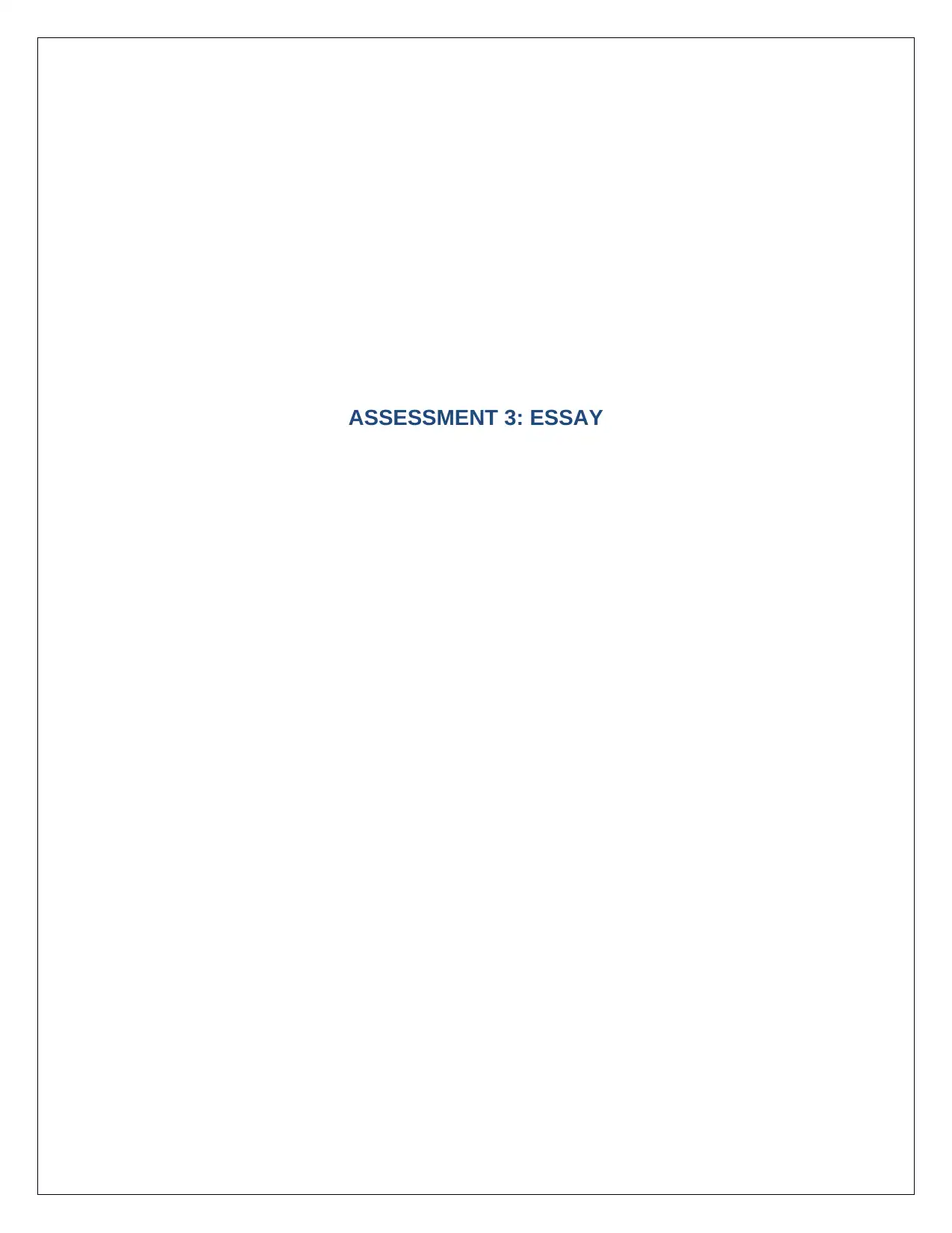
ASSESSMENT 3: ESSAY
Secure Best Marks with AI Grader
Need help grading? Try our AI Grader for instant feedback on your assignments.
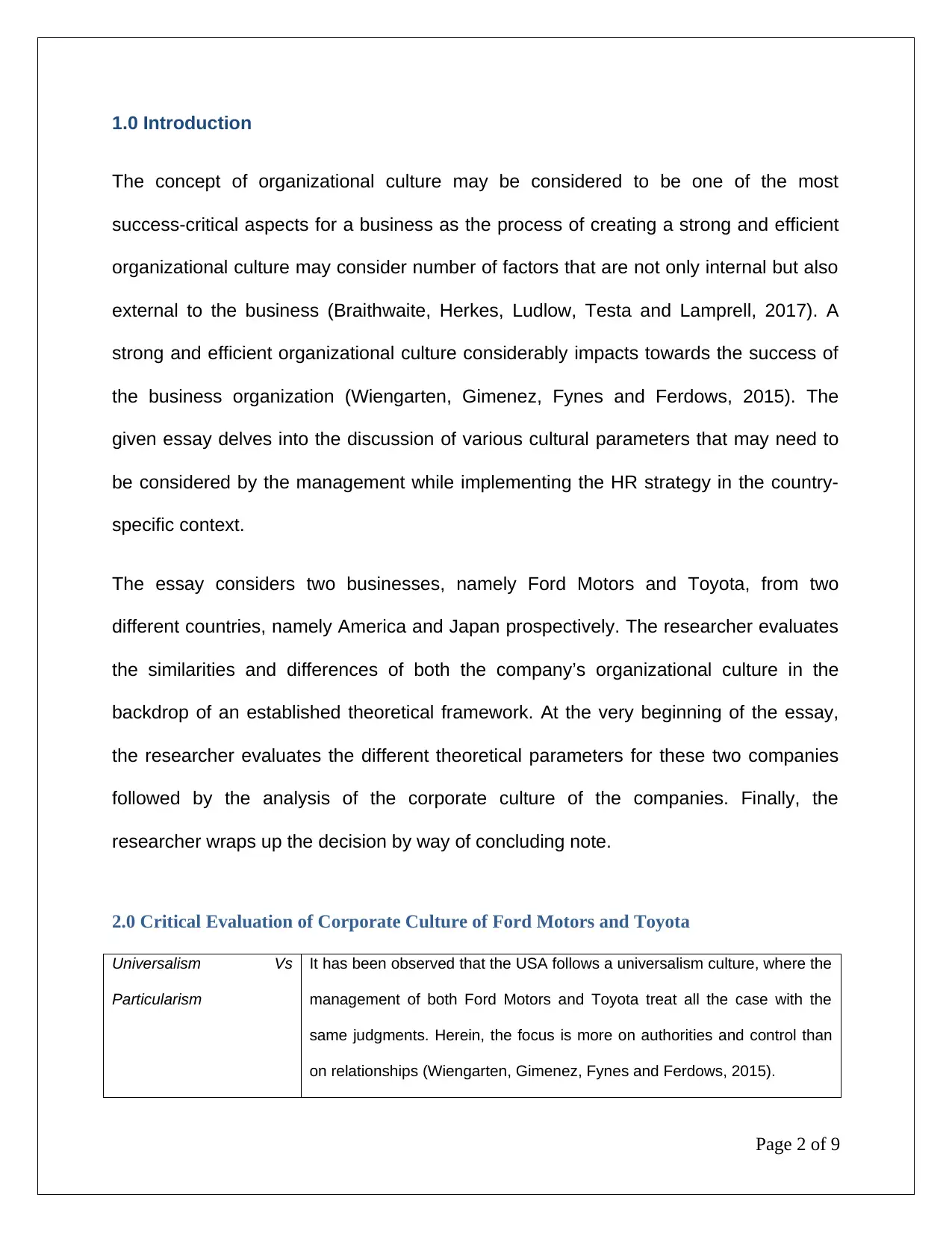
1.0 Introduction
The concept of organizational culture may be considered to be one of the most
success-critical aspects for a business as the process of creating a strong and efficient
organizational culture may consider number of factors that are not only internal but also
external to the business (Braithwaite, Herkes, Ludlow, Testa and Lamprell, 2017). A
strong and efficient organizational culture considerably impacts towards the success of
the business organization (Wiengarten, Gimenez, Fynes and Ferdows, 2015). The
given essay delves into the discussion of various cultural parameters that may need to
be considered by the management while implementing the HR strategy in the country-
specific context.
The essay considers two businesses, namely Ford Motors and Toyota, from two
different countries, namely America and Japan prospectively. The researcher evaluates
the similarities and differences of both the company’s organizational culture in the
backdrop of an established theoretical framework. At the very beginning of the essay,
the researcher evaluates the different theoretical parameters for these two companies
followed by the analysis of the corporate culture of the companies. Finally, the
researcher wraps up the decision by way of concluding note.
2.0 Critical Evaluation of Corporate Culture of Ford Motors and Toyota
Universalism Vs
Particularism
It has been observed that the USA follows a universalism culture, where the
management of both Ford Motors and Toyota treat all the case with the
same judgments. Herein, the focus is more on authorities and control than
on relationships (Wiengarten, Gimenez, Fynes and Ferdows, 2015).
Page 2 of 9
The concept of organizational culture may be considered to be one of the most
success-critical aspects for a business as the process of creating a strong and efficient
organizational culture may consider number of factors that are not only internal but also
external to the business (Braithwaite, Herkes, Ludlow, Testa and Lamprell, 2017). A
strong and efficient organizational culture considerably impacts towards the success of
the business organization (Wiengarten, Gimenez, Fynes and Ferdows, 2015). The
given essay delves into the discussion of various cultural parameters that may need to
be considered by the management while implementing the HR strategy in the country-
specific context.
The essay considers two businesses, namely Ford Motors and Toyota, from two
different countries, namely America and Japan prospectively. The researcher evaluates
the similarities and differences of both the company’s organizational culture in the
backdrop of an established theoretical framework. At the very beginning of the essay,
the researcher evaluates the different theoretical parameters for these two companies
followed by the analysis of the corporate culture of the companies. Finally, the
researcher wraps up the decision by way of concluding note.
2.0 Critical Evaluation of Corporate Culture of Ford Motors and Toyota
Universalism Vs
Particularism
It has been observed that the USA follows a universalism culture, where the
management of both Ford Motors and Toyota treat all the case with the
same judgments. Herein, the focus is more on authorities and control than
on relationships (Wiengarten, Gimenez, Fynes and Ferdows, 2015).
Page 2 of 9

However, Japan follows a Particularism culture, where relationships are
more valued over the powers.
Individualism Vs
Collectivism
The USA follows individualism culture, in which employees are asked to
perform as per their caliber and make decisions accordingly (Braithwaite,
Herkes, Ludlow, Testa and Lamprell, 2017).
On the other hand, Japan follows collectivism culture where employees are
encouraged to work for each other and help others in getting their work
done.
Neutral Vs Effective
relationship
The USA also follows a neutral culture where employees of both Toyota
and Ford Motors do not have the tendency of sharing individual emotions
with others.
On the other side, Japan follows the effective culture, where employees
tend to share their emotions with their colleagues and take advice from
them.
Specific Vs Diffuse
relationships
The USA also maintains a specific culture, where people employees are
advised to keep their personal and professional lives separate (Wiengarten,
Gimenez, Fynes and Ferdows, 2015).
Nevertheless, Japan tends to adopt the diffuse culture where employees'
both personal and professional lives are interconnected.
Achievement Vs
ascription
Both the brands in the USA follow achievement culture, where employees
are even allowed to challenge any decisions of authorities on the grounds of
logical arguments (Wiengarten, Gimenez, Fynes and Ferdows, 2015).
Nevertheless, both the organizations in Japan follow ascription culture
where authorities and management are respected for their earned positions.
Hence, decisions can only be challenged by higher authorities.
Sequential Vs synchronic
time
In sequential culture, time and punctuality play the lead role. The USA
follows this culture where employees prefer completing projects in stages
(Huhtala and Feldt, 2016).
Page 3 of 9
more valued over the powers.
Individualism Vs
Collectivism
The USA follows individualism culture, in which employees are asked to
perform as per their caliber and make decisions accordingly (Braithwaite,
Herkes, Ludlow, Testa and Lamprell, 2017).
On the other hand, Japan follows collectivism culture where employees are
encouraged to work for each other and help others in getting their work
done.
Neutral Vs Effective
relationship
The USA also follows a neutral culture where employees of both Toyota
and Ford Motors do not have the tendency of sharing individual emotions
with others.
On the other side, Japan follows the effective culture, where employees
tend to share their emotions with their colleagues and take advice from
them.
Specific Vs Diffuse
relationships
The USA also maintains a specific culture, where people employees are
advised to keep their personal and professional lives separate (Wiengarten,
Gimenez, Fynes and Ferdows, 2015).
Nevertheless, Japan tends to adopt the diffuse culture where employees'
both personal and professional lives are interconnected.
Achievement Vs
ascription
Both the brands in the USA follow achievement culture, where employees
are even allowed to challenge any decisions of authorities on the grounds of
logical arguments (Wiengarten, Gimenez, Fynes and Ferdows, 2015).
Nevertheless, both the organizations in Japan follow ascription culture
where authorities and management are respected for their earned positions.
Hence, decisions can only be challenged by higher authorities.
Sequential Vs synchronic
time
In sequential culture, time and punctuality play the lead role. The USA
follows this culture where employees prefer completing projects in stages
(Huhtala and Feldt, 2016).
Page 3 of 9
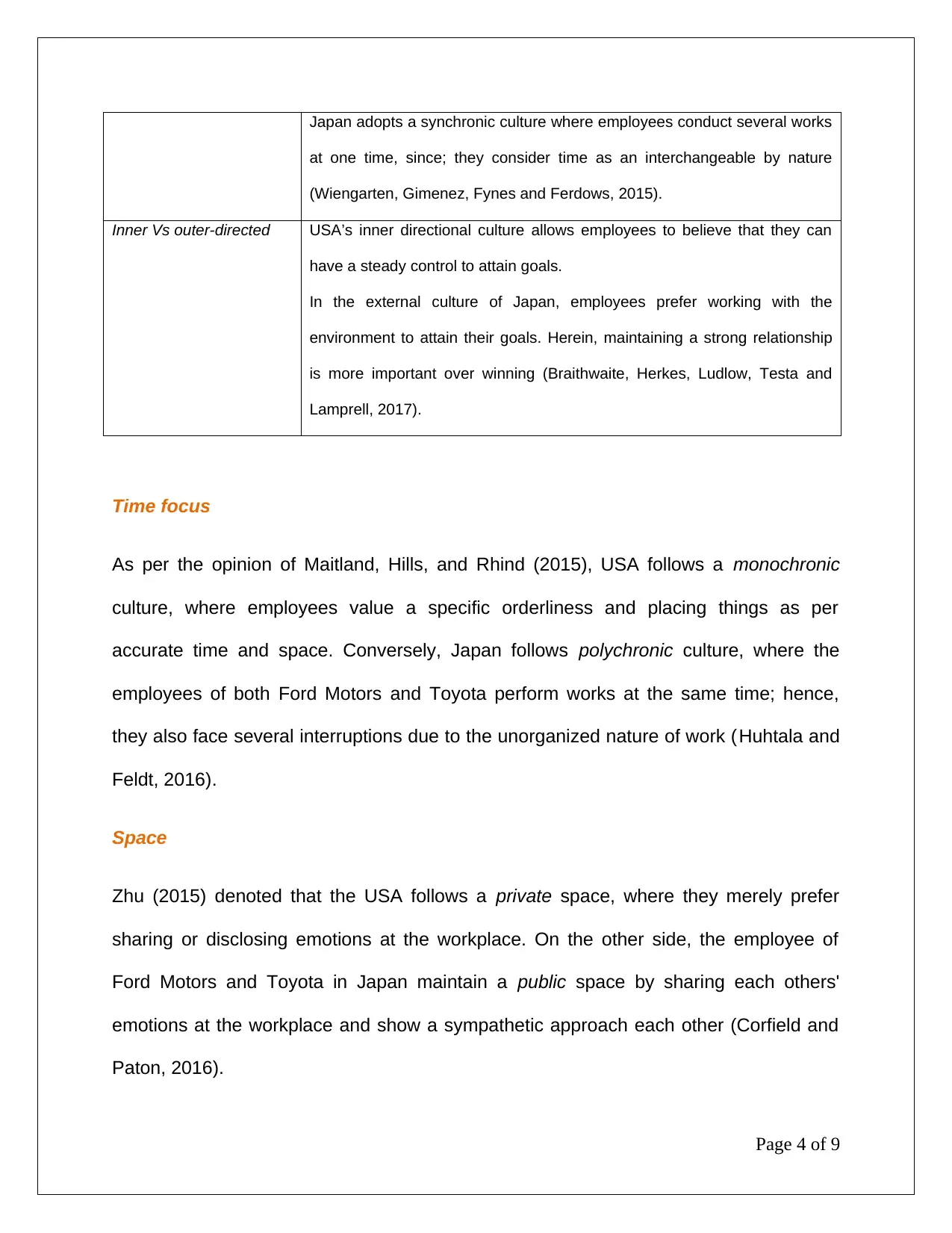
Japan adopts a synchronic culture where employees conduct several works
at one time, since; they consider time as an interchangeable by nature
(Wiengarten, Gimenez, Fynes and Ferdows, 2015).
Inner Vs outer-directed USA’s inner directional culture allows employees to believe that they can
have a steady control to attain goals.
In the external culture of Japan, employees prefer working with the
environment to attain their goals. Herein, maintaining a strong relationship
is more important over winning (Braithwaite, Herkes, Ludlow, Testa and
Lamprell, 2017).
Time focus
As per the opinion of Maitland, Hills, and Rhind (2015), USA follows a monochronic
culture, where employees value a specific orderliness and placing things as per
accurate time and space. Conversely, Japan follows polychronic culture, where the
employees of both Ford Motors and Toyota perform works at the same time; hence,
they also face several interruptions due to the unorganized nature of work (Huhtala and
Feldt, 2016).
Space
Zhu (2015) denoted that the USA follows a private space, where they merely prefer
sharing or disclosing emotions at the workplace. On the other side, the employee of
Ford Motors and Toyota in Japan maintain a public space by sharing each others'
emotions at the workplace and show a sympathetic approach each other (Corfield and
Paton, 2016).
Page 4 of 9
at one time, since; they consider time as an interchangeable by nature
(Wiengarten, Gimenez, Fynes and Ferdows, 2015).
Inner Vs outer-directed USA’s inner directional culture allows employees to believe that they can
have a steady control to attain goals.
In the external culture of Japan, employees prefer working with the
environment to attain their goals. Herein, maintaining a strong relationship
is more important over winning (Braithwaite, Herkes, Ludlow, Testa and
Lamprell, 2017).
Time focus
As per the opinion of Maitland, Hills, and Rhind (2015), USA follows a monochronic
culture, where employees value a specific orderliness and placing things as per
accurate time and space. Conversely, Japan follows polychronic culture, where the
employees of both Ford Motors and Toyota perform works at the same time; hence,
they also face several interruptions due to the unorganized nature of work (Huhtala and
Feldt, 2016).
Space
Zhu (2015) denoted that the USA follows a private space, where they merely prefer
sharing or disclosing emotions at the workplace. On the other side, the employee of
Ford Motors and Toyota in Japan maintain a public space by sharing each others'
emotions at the workplace and show a sympathetic approach each other (Corfield and
Paton, 2016).
Page 4 of 9
Secure Best Marks with AI Grader
Need help grading? Try our AI Grader for instant feedback on your assignments.
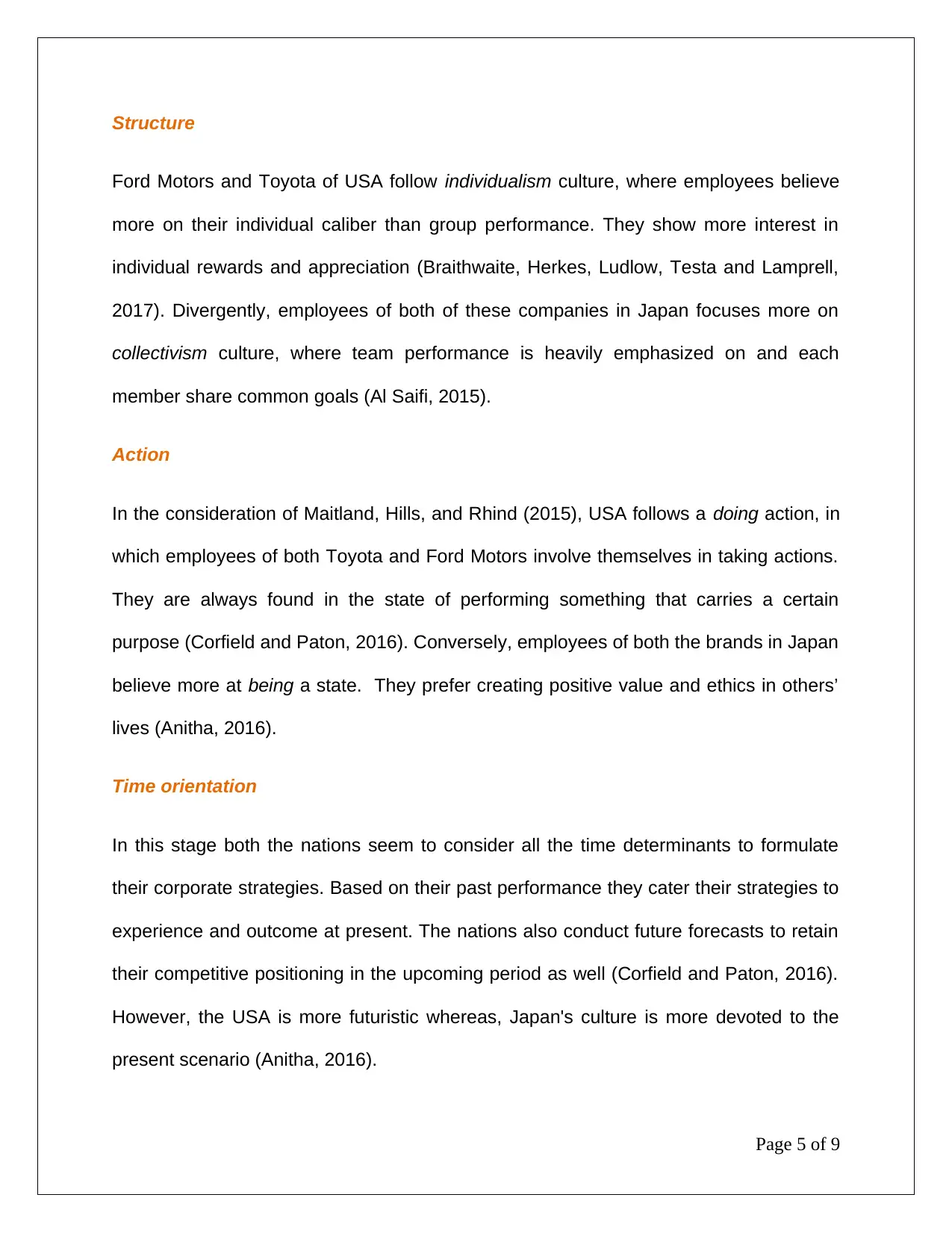
Structure
Ford Motors and Toyota of USA follow individualism culture, where employees believe
more on their individual caliber than group performance. They show more interest in
individual rewards and appreciation (Braithwaite, Herkes, Ludlow, Testa and Lamprell,
2017). Divergently, employees of both of these companies in Japan focuses more on
collectivism culture, where team performance is heavily emphasized on and each
member share common goals (Al Saifi, 2015).
Action
In the consideration of Maitland, Hills, and Rhind (2015), USA follows a doing action, in
which employees of both Toyota and Ford Motors involve themselves in taking actions.
They are always found in the state of performing something that carries a certain
purpose (Corfield and Paton, 2016). Conversely, employees of both the brands in Japan
believe more at being a state. They prefer creating positive value and ethics in others’
lives (Anitha, 2016).
Time orientation
In this stage both the nations seem to consider all the time determinants to formulate
their corporate strategies. Based on their past performance they cater their strategies to
experience and outcome at present. The nations also conduct future forecasts to retain
their competitive positioning in the upcoming period as well (Corfield and Paton, 2016).
However, the USA is more futuristic whereas, Japan's culture is more devoted to the
present scenario (Anitha, 2016).
Page 5 of 9
Ford Motors and Toyota of USA follow individualism culture, where employees believe
more on their individual caliber than group performance. They show more interest in
individual rewards and appreciation (Braithwaite, Herkes, Ludlow, Testa and Lamprell,
2017). Divergently, employees of both of these companies in Japan focuses more on
collectivism culture, where team performance is heavily emphasized on and each
member share common goals (Al Saifi, 2015).
Action
In the consideration of Maitland, Hills, and Rhind (2015), USA follows a doing action, in
which employees of both Toyota and Ford Motors involve themselves in taking actions.
They are always found in the state of performing something that carries a certain
purpose (Corfield and Paton, 2016). Conversely, employees of both the brands in Japan
believe more at being a state. They prefer creating positive value and ethics in others’
lives (Anitha, 2016).
Time orientation
In this stage both the nations seem to consider all the time determinants to formulate
their corporate strategies. Based on their past performance they cater their strategies to
experience and outcome at present. The nations also conduct future forecasts to retain
their competitive positioning in the upcoming period as well (Corfield and Paton, 2016).
However, the USA is more futuristic whereas, Japan's culture is more devoted to the
present scenario (Anitha, 2016).
Page 5 of 9
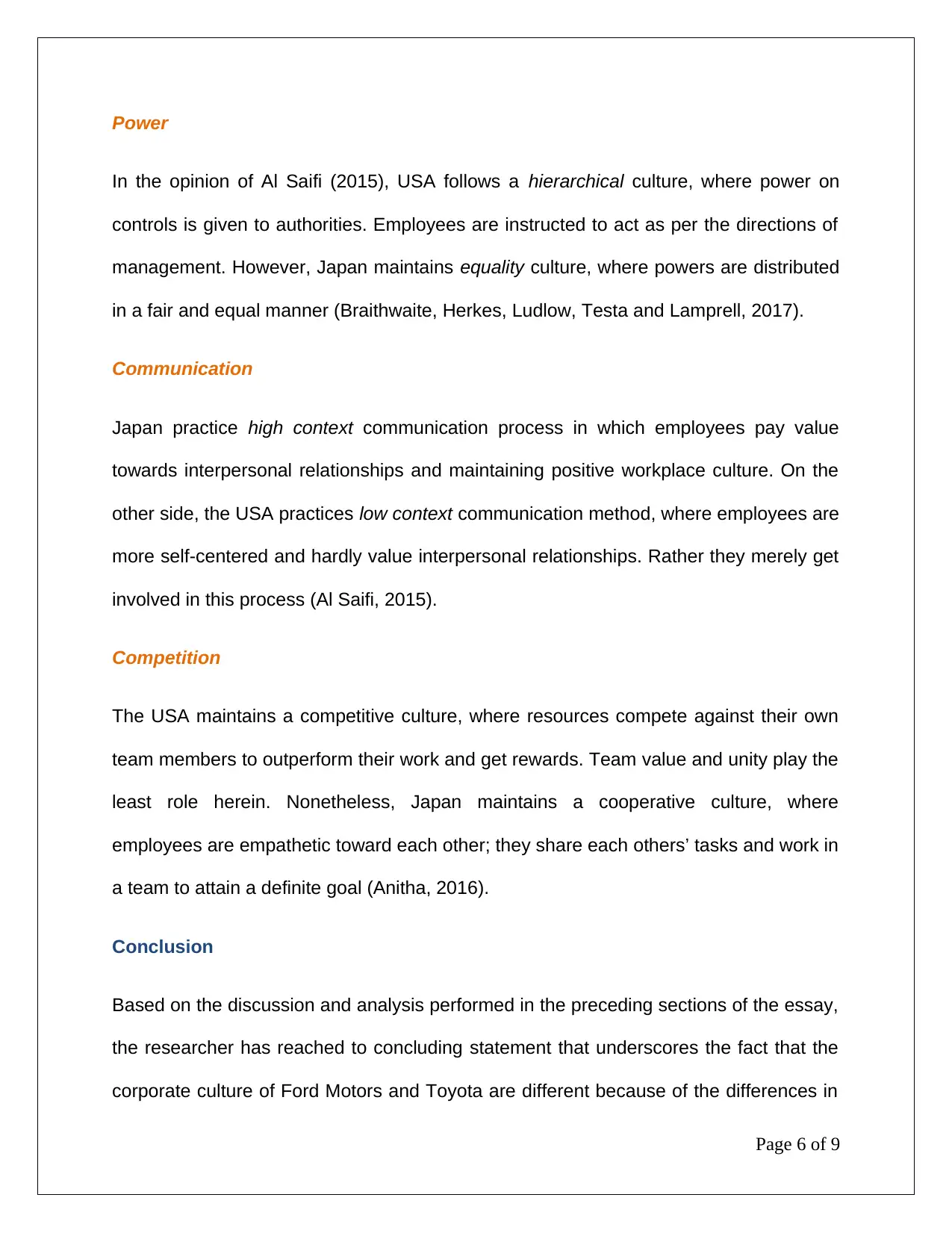
Power
In the opinion of Al Saifi (2015), USA follows a hierarchical culture, where power on
controls is given to authorities. Employees are instructed to act as per the directions of
management. However, Japan maintains equality culture, where powers are distributed
in a fair and equal manner (Braithwaite, Herkes, Ludlow, Testa and Lamprell, 2017).
Communication
Japan practice high context communication process in which employees pay value
towards interpersonal relationships and maintaining positive workplace culture. On the
other side, the USA practices low context communication method, where employees are
more self-centered and hardly value interpersonal relationships. Rather they merely get
involved in this process (Al Saifi, 2015).
Competition
The USA maintains a competitive culture, where resources compete against their own
team members to outperform their work and get rewards. Team value and unity play the
least role herein. Nonetheless, Japan maintains a cooperative culture, where
employees are empathetic toward each other; they share each others’ tasks and work in
a team to attain a definite goal (Anitha, 2016).
Conclusion
Based on the discussion and analysis performed in the preceding sections of the essay,
the researcher has reached to concluding statement that underscores the fact that the
corporate culture of Ford Motors and Toyota are different because of the differences in
Page 6 of 9
In the opinion of Al Saifi (2015), USA follows a hierarchical culture, where power on
controls is given to authorities. Employees are instructed to act as per the directions of
management. However, Japan maintains equality culture, where powers are distributed
in a fair and equal manner (Braithwaite, Herkes, Ludlow, Testa and Lamprell, 2017).
Communication
Japan practice high context communication process in which employees pay value
towards interpersonal relationships and maintaining positive workplace culture. On the
other side, the USA practices low context communication method, where employees are
more self-centered and hardly value interpersonal relationships. Rather they merely get
involved in this process (Al Saifi, 2015).
Competition
The USA maintains a competitive culture, where resources compete against their own
team members to outperform their work and get rewards. Team value and unity play the
least role herein. Nonetheless, Japan maintains a cooperative culture, where
employees are empathetic toward each other; they share each others’ tasks and work in
a team to attain a definite goal (Anitha, 2016).
Conclusion
Based on the discussion and analysis performed in the preceding sections of the essay,
the researcher has reached to concluding statement that underscores the fact that the
corporate culture of Ford Motors and Toyota are different because of the differences in
Page 6 of 9
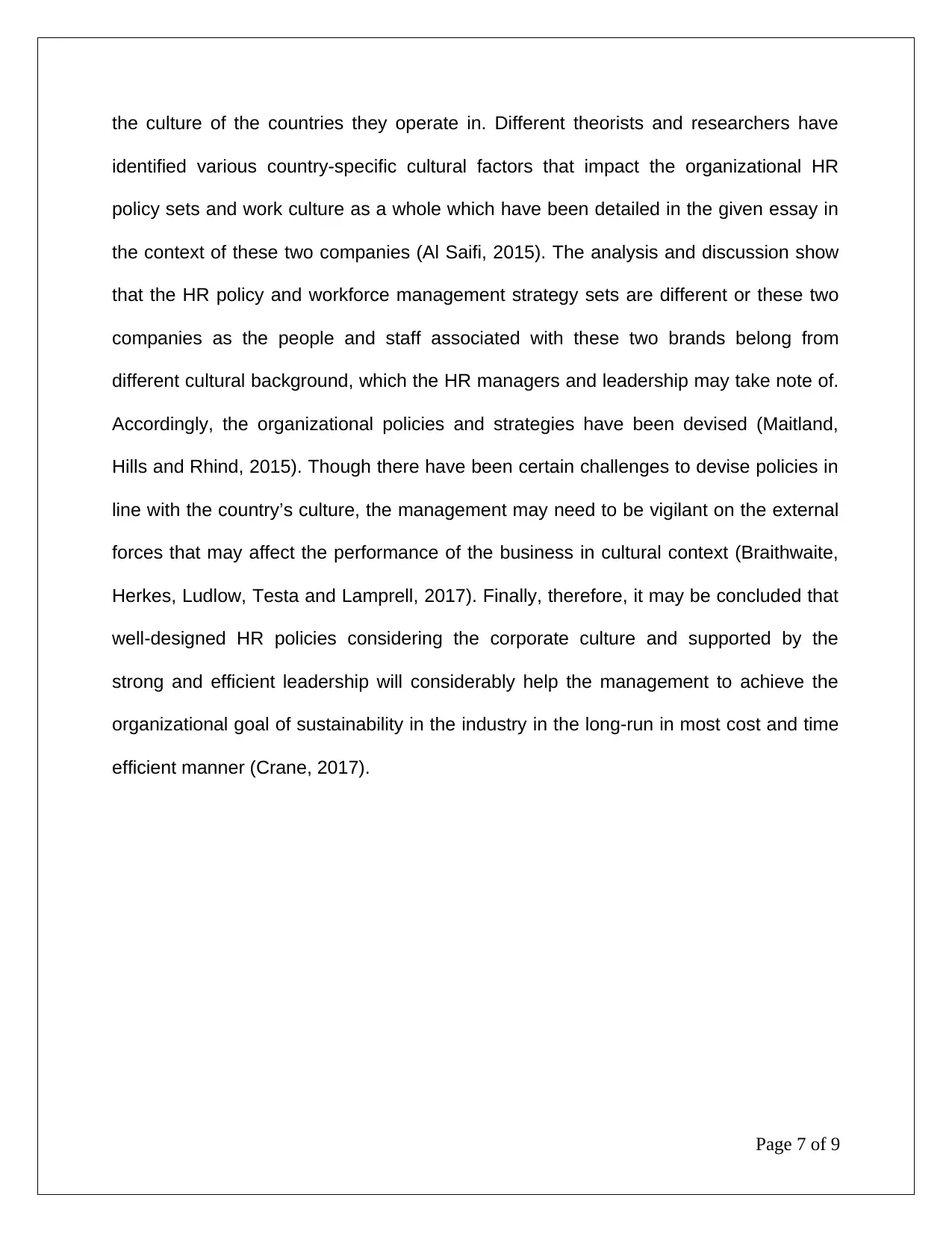
the culture of the countries they operate in. Different theorists and researchers have
identified various country-specific cultural factors that impact the organizational HR
policy sets and work culture as a whole which have been detailed in the given essay in
the context of these two companies (Al Saifi, 2015). The analysis and discussion show
that the HR policy and workforce management strategy sets are different or these two
companies as the people and staff associated with these two brands belong from
different cultural background, which the HR managers and leadership may take note of.
Accordingly, the organizational policies and strategies have been devised (Maitland,
Hills and Rhind, 2015). Though there have been certain challenges to devise policies in
line with the country’s culture, the management may need to be vigilant on the external
forces that may affect the performance of the business in cultural context (Braithwaite,
Herkes, Ludlow, Testa and Lamprell, 2017). Finally, therefore, it may be concluded that
well-designed HR policies considering the corporate culture and supported by the
strong and efficient leadership will considerably help the management to achieve the
organizational goal of sustainability in the industry in the long-run in most cost and time
efficient manner (Crane, 2017).
Page 7 of 9
identified various country-specific cultural factors that impact the organizational HR
policy sets and work culture as a whole which have been detailed in the given essay in
the context of these two companies (Al Saifi, 2015). The analysis and discussion show
that the HR policy and workforce management strategy sets are different or these two
companies as the people and staff associated with these two brands belong from
different cultural background, which the HR managers and leadership may take note of.
Accordingly, the organizational policies and strategies have been devised (Maitland,
Hills and Rhind, 2015). Though there have been certain challenges to devise policies in
line with the country’s culture, the management may need to be vigilant on the external
forces that may affect the performance of the business in cultural context (Braithwaite,
Herkes, Ludlow, Testa and Lamprell, 2017). Finally, therefore, it may be concluded that
well-designed HR policies considering the corporate culture and supported by the
strong and efficient leadership will considerably help the management to achieve the
organizational goal of sustainability in the industry in the long-run in most cost and time
efficient manner (Crane, 2017).
Page 7 of 9
Paraphrase This Document
Need a fresh take? Get an instant paraphrase of this document with our AI Paraphraser
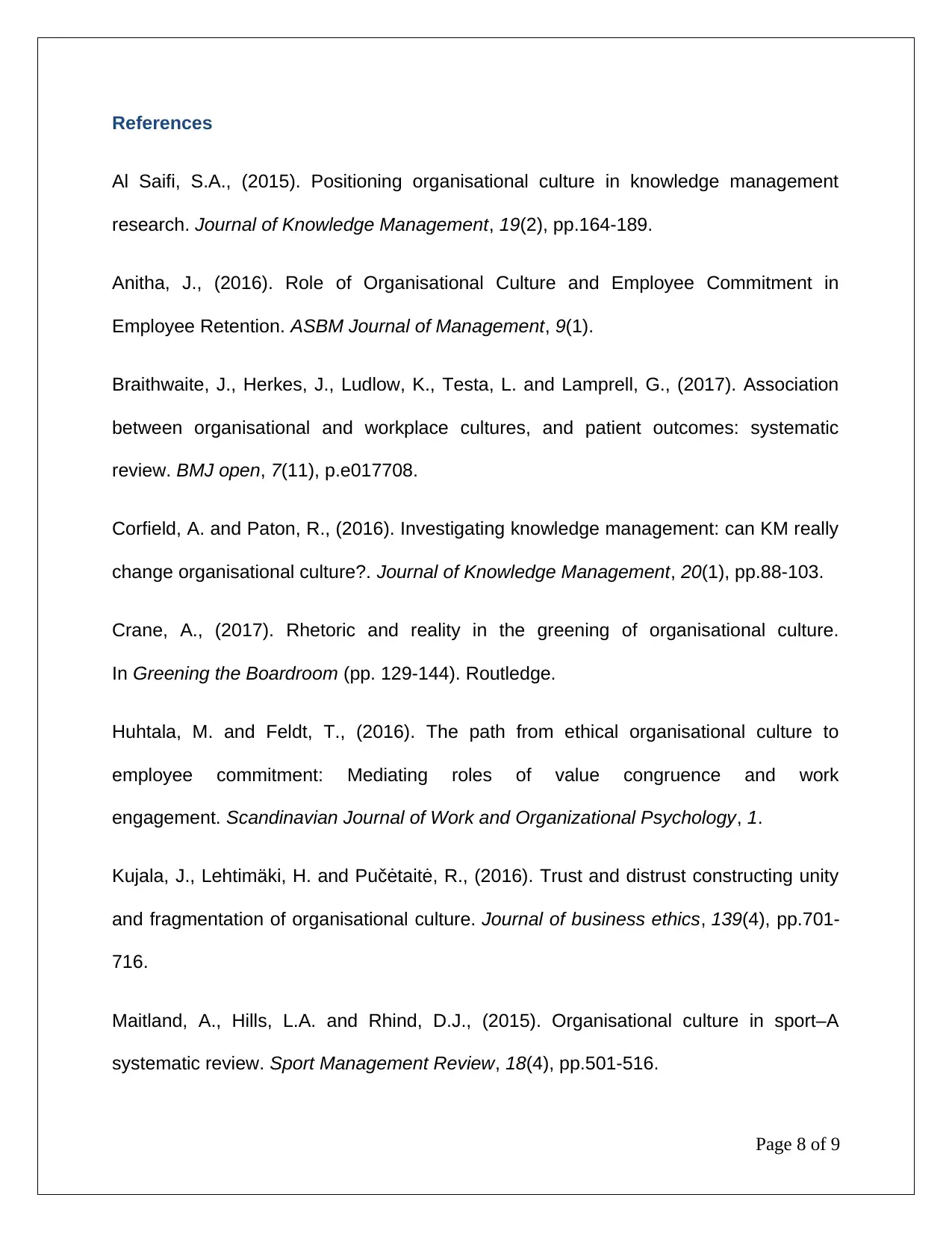
References
Al Saifi, S.A., (2015). Positioning organisational culture in knowledge management
research. Journal of Knowledge Management, 19(2), pp.164-189.
Anitha, J., (2016). Role of Organisational Culture and Employee Commitment in
Employee Retention. ASBM Journal of Management, 9(1).
Braithwaite, J., Herkes, J., Ludlow, K., Testa, L. and Lamprell, G., (2017). Association
between organisational and workplace cultures, and patient outcomes: systematic
review. BMJ open, 7(11), p.e017708.
Corfield, A. and Paton, R., (2016). Investigating knowledge management: can KM really
change organisational culture?. Journal of Knowledge Management, 20(1), pp.88-103.
Crane, A., (2017). Rhetoric and reality in the greening of organisational culture.
In Greening the Boardroom (pp. 129-144). Routledge.
Huhtala, M. and Feldt, T., (2016). The path from ethical organisational culture to
employee commitment: Mediating roles of value congruence and work
engagement. Scandinavian Journal of Work and Organizational Psychology, 1.
Kujala, J., Lehtimäki, H. and Pučėtaitė, R., (2016). Trust and distrust constructing unity
and fragmentation of organisational culture. Journal of business ethics, 139(4), pp.701-
716.
Maitland, A., Hills, L.A. and Rhind, D.J., (2015). Organisational culture in sport–A
systematic review. Sport Management Review, 18(4), pp.501-516.
Page 8 of 9
Al Saifi, S.A., (2015). Positioning organisational culture in knowledge management
research. Journal of Knowledge Management, 19(2), pp.164-189.
Anitha, J., (2016). Role of Organisational Culture and Employee Commitment in
Employee Retention. ASBM Journal of Management, 9(1).
Braithwaite, J., Herkes, J., Ludlow, K., Testa, L. and Lamprell, G., (2017). Association
between organisational and workplace cultures, and patient outcomes: systematic
review. BMJ open, 7(11), p.e017708.
Corfield, A. and Paton, R., (2016). Investigating knowledge management: can KM really
change organisational culture?. Journal of Knowledge Management, 20(1), pp.88-103.
Crane, A., (2017). Rhetoric and reality in the greening of organisational culture.
In Greening the Boardroom (pp. 129-144). Routledge.
Huhtala, M. and Feldt, T., (2016). The path from ethical organisational culture to
employee commitment: Mediating roles of value congruence and work
engagement. Scandinavian Journal of Work and Organizational Psychology, 1.
Kujala, J., Lehtimäki, H. and Pučėtaitė, R., (2016). Trust and distrust constructing unity
and fragmentation of organisational culture. Journal of business ethics, 139(4), pp.701-
716.
Maitland, A., Hills, L.A. and Rhind, D.J., (2015). Organisational culture in sport–A
systematic review. Sport Management Review, 18(4), pp.501-516.
Page 8 of 9
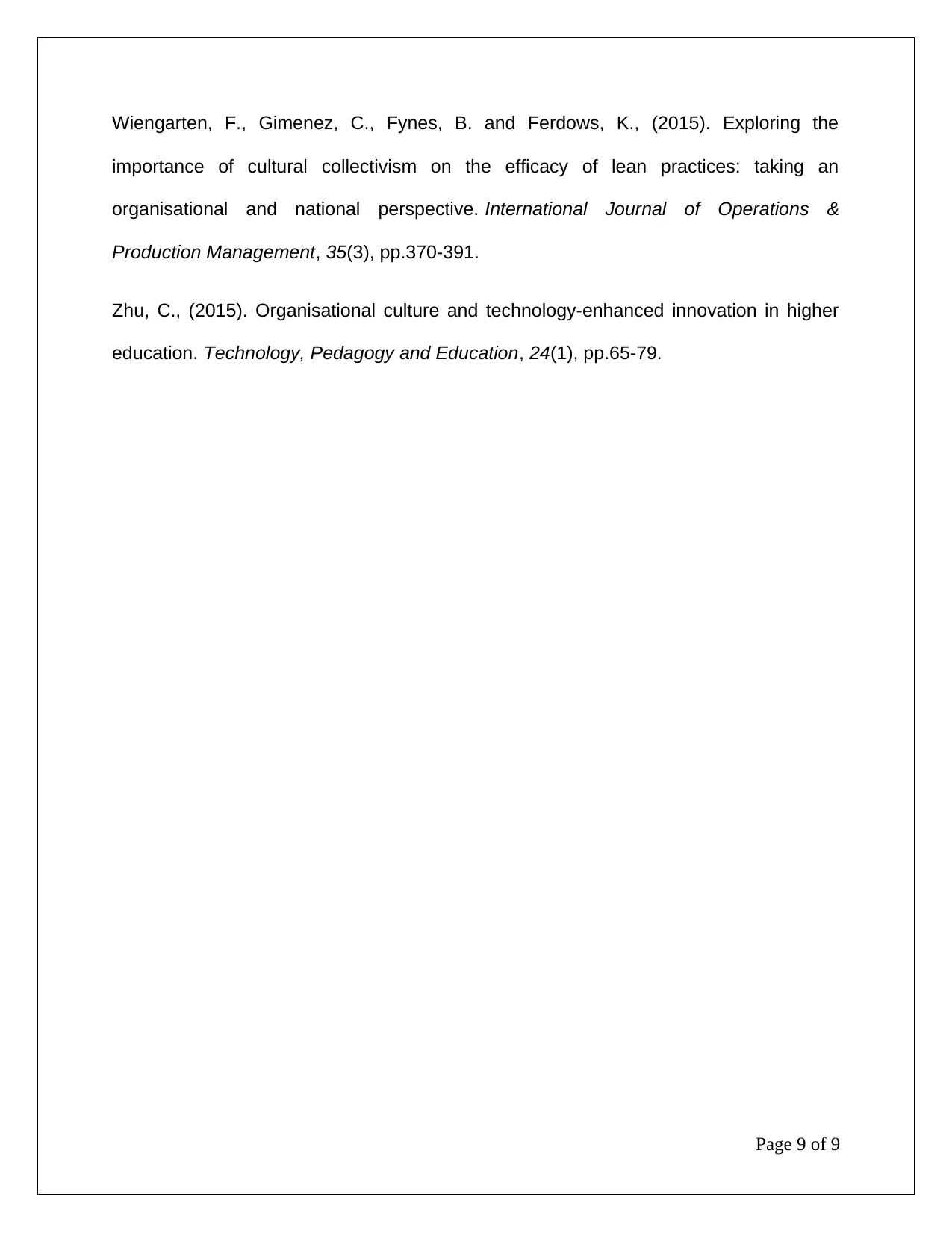
Wiengarten, F., Gimenez, C., Fynes, B. and Ferdows, K., (2015). Exploring the
importance of cultural collectivism on the efficacy of lean practices: taking an
organisational and national perspective. International Journal of Operations &
Production Management, 35(3), pp.370-391.
Zhu, C., (2015). Organisational culture and technology-enhanced innovation in higher
education. Technology, Pedagogy and Education, 24(1), pp.65-79.
Page 9 of 9
importance of cultural collectivism on the efficacy of lean practices: taking an
organisational and national perspective. International Journal of Operations &
Production Management, 35(3), pp.370-391.
Zhu, C., (2015). Organisational culture and technology-enhanced innovation in higher
education. Technology, Pedagogy and Education, 24(1), pp.65-79.
Page 9 of 9
1 out of 9
Your All-in-One AI-Powered Toolkit for Academic Success.
+13062052269
info@desklib.com
Available 24*7 on WhatsApp / Email
![[object Object]](/_next/static/media/star-bottom.7253800d.svg)
Unlock your academic potential
© 2024 | Zucol Services PVT LTD | All rights reserved.